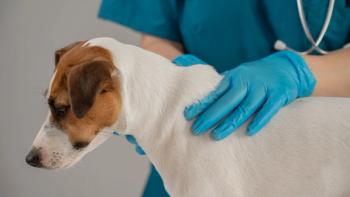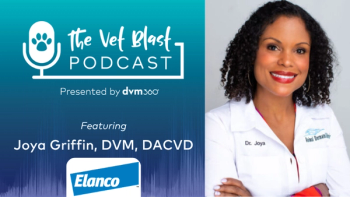
Treating canine otitis: So many options, how do I choose?
Topicals, systemics, antibacterials, antifungals, glucocorticoids The list of potential therapies is long, but with the right diagnostic information and patient history details, you can formulate a regimen that gets those ears under control.
Shutterstock.comOnce you've diagnosed an otic infection, it's time to put together your treatment plan. Topical therapy is almost always a staple of treatment, and systemic antimicrobials may be necessary as well. At each recheck, you'll be monitoring the patient's response to treatment, performing cytology, and adjusting products accordingly.
In most cases of infectious otitis externa, topical therapy alone is enough. In patients with severe infections or with long-standing chronic otitis externa, you may need to add a systemic antimicrobial agent to clear the infection in the ear tissue as well as in the lumen of the ear canal. Dogs with concurrent infectious otitis externa and otitis media usually require both topical and systemic antimicrobial therapy.
Topical options: A rundown
Topical otic preparations generally contain glucocorticoids, antibiotics, antifungals or some combination thereof in a vehicle base. Rely on your cytology results to select the right active ingredient for topical use. Remember, culture and sensitivity testing results indicate the plasma level of an antimicrobial agent. The advantage of topical therapy is that you can achieve 100 to 1,000 times the plasma level of the antimicrobial agent by administering it topically. Cytologically monitor your patient's response to these medications at each reevaluation and adjust the topical therapy accordingly.
No commercially available topical otic treatments are labeled for use with a non-intact tympanic membrane, but most of them have been used to treat otic infections in dogs with otitis media. Warn clients to watch for neurological signs of ototoxicity while administering topical medications when the tympanic membrane is not intact.
With that note, let's look at topical agents one at a time.
Glucocorticoids are antipruritic, anti-inflammatory and antiproliferative. During the acute stage of otitis, the ear canal becomes edematous and erythematous. As the inflammation progresses, the dermis becomes infiltrated with a mixed population of cells. Apocrine glands dilate and become hyperplastic, which leads to excessive cerumen production.
Glucocorticoids are therefore beneficial in decreasing the pain, pruritus, stenosis and edema associated with otitis. In addition, they're effective in decreasing sebaceous and apocrine secretions. They're usually used in combination with other agents but may be beneficial when used alone in allergic cases of otitis and some ceruminous otitis cases. It's important to use the lowest-potency glucocorticoid at the lowest frequency needed to control the otitis to prevent iatrogenic hyperadrenocorticism. Examples include Cort/Astrin Solution (Vedco) and Synotic (Zoetis).
Topical aminoglycosides such as neomycin and gentamicin have good activity against gram-positive and gram-negative otic pathogens for the treatment of acute otitis externa. Gentamicin and neomycin are available in many combination products, some of which contain an antifungal and glucocorticoid, such as Tresaderm (Merial/Bohringer Ingelheim), Otomax Ointment (Merck), Mometamax Suspension (Merck), Panolog Ointment (Zoetis) and easOtic Suspension (Virbac). Another aminoglycoside, tobramycin, is available as an ophthalmic solution (generic) and is very effective against otitis infections caused by Pseudomonas species, especially in cases of chronic otitis externa.
Fluoroquinolones have a broad spectrum of antibacterial activity against gram-negative and gram-positive bacteria and are found in Baytril Otic emulsion (Bayer) and Posatex Otic Suspension (Merck). Note that fluoroquinolones are a second-line treatment for chronic otitis externa cases, not acute infections.
Polymyxin has excellent in vitro activity against Pseudomonas species with resistance rarely developing, but it's inactivated in purulent debris so the ear needs to be kept clean during treatment. Several generic products contain polymyxin, as well as Surolan (Elanco).
Florfenicol has been available for a number of years as a fast-acting, long-lasting injectable antibiotic for the treatment of bovine respiratory disease. Recently, two new otic medications (Claro-Bayer; Osurnia-Elanco) have been approved for the treatment of bacteria (Staphylococcus pseudintermedius) and yeast (due to the addition of terbinafine in the products). They also contain a topical glucocorticoid.
Tris-EDTA is a topical product that enhances the activity of topical antibiotics against otic pathogens by decreasing stability and increasing the permeability of the cell wall of gram-negative bacteria. There are numerous products containing Tris-EDTA: TrizEDTA (Dechra), TrizUltra + Keto (with ketoconazole) (Dechra), TrizChlor (with chlorhexidine) (Dechra), Mal-A-Ket Plus TrizEDTA Flush (with ketoconazole and chlorhexidine) (Dechra), and T8 Keto (with ketoconazole) (Bayer).
Antifungal agents are used in cases of otitis caused by Malassezia or Candida species. Ingredients that are active against yeast include nystatin (Panolog), thiabendazole (Tresaderm), miconazole (generics, Surolan, easOtic), ketoconazole (TrizUltra, T8 Keto), posaconazole (Posatex), clotrimazole (Otomax, Mometamax), and terbinafine (Claro, Osurnia).
An extralabel topical preparation containing enrofloxacin may be formulated as a second-line treatment in chronic cases using one part injectable enrofloxacin (22.7 mg/ml) to four parts an appropriate vehicle (Cort/Astrin, for example) or one part injectable enrofloxacin to one part miconazole to one part injectable dexamethasone (2 mg/kg). Topical enrofloxacin appears to be very effective for treatment of otitis due to Pseudomonas species. Silver sulfadiazine 1% (Silvadene-Pfizer) is available in a cream formulation. One part of the Silvadene cream can be mixed with one part TrizChlor prior to application in the ear and has been shown to be very effective against resistant Pseudomonas species. For inflamed ears with yeast otitis without a bacterial component, a topical antifungal such as miconazole may be mixed 1:1 with dexamethasone.
How to choose
So how do you decide which topical products to choose? Start with the chronicity of the otitis, the results of your otic examination, and your otic cytology results. The results of cytologic examination of otic exudate are the basis for your selection of the active ingredient. Keep in mind that ointment- or suspension-based otic preparations may not be as effective as those that are solution- or emulsion-based if the ears are stenotic or hyperplastic, as may be the case in those patients with chronic otitis externa, but they can be used if the ears aren't stenotic or hyperplastic or in patients with acute otitis externa.
Choose first-line topical otic medications for cases of acute or occasional otitis externa, reserving second-line otic medications, such as those containing fluoroquinolones, for cases of bacterial otitis due to Pseudomonas species or chronic infections that haven't responded to first-line topical otic antimicrobial products.
Systemic considerations
Systemic antimicrobial therapy for infectious otitis externa and otitis media is controversial. In dogs with end-stage otitis externa and concurrent otitis media, bacterial organisms can be isolated from the exudate in the lumen of the vertical ear canal and middle ear cavity as well as from the tissue from these sites. So most experts agree that systemic antibiotics-based on culture and susceptibility testing-are indicated in patients with:
- otitis media
- severe proliferative chronic otitis externa
- ulcerative otitis externa
- inflammatory cells seen on cytology (indicating deeper skin involvement)
- owners who cannot administer topical therapy.
It's important to select a systemic antimicrobial agent based on culture and susceptibility testing from the external ear (for otitis externa) and middle ear (for otitis media), but go ahead and initiate therapy based on cytologic results while you're waiting on culture and susceptibility results.
Indications for systemic antifungal agents are similar to those for bacterial infections. Use systemic products in patients with yeast otitis media or severe yeast otitis externa and for owners who cannot administer topical therapy. Otic yeast infections require topical therapy in addition to systemic therapy for resolution. Both ketoconazole and itraconazole have been used in dogs for the treatment of yeast otitis.
Systemic glucocorticoids are used to decrease stenosis, edema and hyperplasia of the vertical and horizontal ear canal to allow a complete otic examination as well as proper cleaning of the ear. They're also indicated in cases of allergic otitis externa. In older patients or those with concurrent diseases, you may need to perform bloodwork before starting your patient on glucocorticoids. Aim to use the lowest dose needed to prevent side effects, with the end goal of discontinuing the systemic glucocorticoid.
Dr. Lynette Cole is a professor of dermatology at The Ohio State University College of Veterinary Medicine. This article is adapted from her proceedings for a Bayer-sponsored session at the 2017 Fetch dvm360 conference in San Diego.
Newsletter
From exam room tips to practice management insights, get trusted veterinary news delivered straight to your inbox—subscribe to dvm360.




